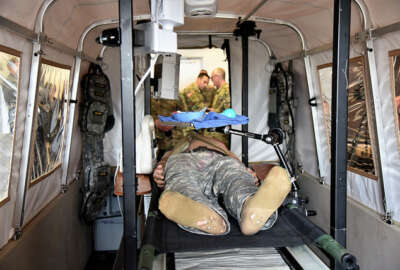 Exclusive
Exclusive Pentagon announces plan to downsize nearly 50 hospitals, clinics
DoD's plan to restructure military treatment facilities would affect 50 hospitals and clinics, primarily by restricting their services to active duty service...
Best listening experience is on Chrome, Firefox or Safari. Subscribe to Federal Drive’s daily audio interviews on Apple Podcasts or PodcastOne.
An estimated 200,000 military family members and retirees would lose their ability to get health care through military hospitals and clinics under a “rightsizing” plan the Defense Department sent to Congress on Wednesday.
The blueprint, if fully implemented, would amount to significant restructuring of the military health system’s responsibilities in the continental U.S. over the next several years. The list includes 50 existing military treatment facilities (MTFs) whose service offerings would change in some way.
In a handful of cases, hospitals and clinics would expand their ability to deliver care. But 37 of them would stop seeing family members and retirees, and only treat active duty military members. In other cases, hospitals and surgery centers would be downgraded to outpatient clinics, and at least three facilities would close altogether. Most existing pharmacies would continue to fill beneficiaries prescriptions.
Defense health officials said the changes were primarily geared toward increasing the military readiness of DoD’s own uniformed clinicians by focusing them on the same active duty populations they would be expected to care for in wartime settings.
“What we found in our review is that many of these facilities do not have the type of patient case load, volume, acuity that we need for our providers to be proficient in what they do downrange,” Thomas McCaffery, the assistant secretary of Defense for health affairs told reporters on a conference call. “And so by limiting the scope of services, that will allow us to take some of those providers and place them at other MTFs that do have that direct match for their readiness requirements.”
(Story continues below map)
However, the prospect of cost savings played at least some role in the decisions, which were first reported by Military.com. In its 2021 budget proposal for the Defense Health Program, the Pentagon estimated it would save $36 million during the first year of the transition by moving some patients from MTFs to private providers in DoD’s TRICARE system.
The budget submission tagged those savings as part of the Defense-Wide Review Secretary Mark Esper ordered last year. The initiative was meant to reduce spending in the DoD agencies outside the military departments and redirect funds toward weapons systems and other programs that line up with the priorities the Pentagon has outlined in the National Defense Strategy.
“We have generally found that through our contracts that our care often is cheaper in the network from a government purchase point of view than the cost of actually doing it within our direct care system in some locations,” said Dr. David Smith, the leader of the department’s health care management reform initiative. “Clearly, as part of our methodology, that was one of the questions that we asked, but the principal question was, ‘Are we getting readiness value out of this location? Is it worth the cost compared to putting that somewhere else in the system?’”
Defense officials emphasized the changes would not happen overnight. For one thing, the plans could still be blocked in whole or in part by Congress. And in any event, the department vowed it would not begin downsizing any individual MTF until it was certain that private providers in the local area could handle the increased workload from DoD’s retirees and family members.
And answering those questions market-by-market will take further study, McCaffery said.
“Before we transition any beneficiary from one of our hospitals or clinics, we will connect them with healthcare providers in our TRICARE network and as you might expect, that process will take time,” he said. “In several locations, it could be several years for implementation. The bottom line for our beneficiaries is that we will help guide them through every step of the enrollment change process, and when the time for action arrives, we will implement changes in a deliberate fashion at a pace local healthcare markets can handle.”
Of the 200,000 beneficiaries affected, DoD estimates roughly 80,000 are family members of active duty service members, and 120,000 are retirees.
Rep. Jackie Speier (D-Calif.), the chairwoman of the House military personnel subcommittee, said she was concerned that the plan appeared to be born from a “haste to cut costs.”
“It is important to control costs and make the system more efficient, but the goal should not be to shift care for perceived savings without proper data and analysis,” Speier said in a statement. “We can and must always seek efficiencies with the goal of using those savings to address critical shortfalls and improve medical care for our servicemembers, families, and retirees. In this case, we need to be certain that the DoD is not jeopardizing our military health care system for the sake of other spending.”
The downsizing plan comes during what is already a period of massive change throughout the Military Health System. DoD is simultaneously conducting major technological upgrades, including a new electronic health record, implementing new contracts in its TRICARE system, and transitioning the management of all of its clinics and hospitals from the military services to the Defense Health Agency — a process some senior military service officials have openly criticized.
Defense officials said that although DHA would be in charge of managing the downsizing process, decisions about which hospitals and clinics would be affected were made by the Pentagon, not DHA itself.
Separately, the military services have also started major realignment of their medical staff that would eventually eliminate 18,000 uniformed medical positions, but that process is on hold amidst Congressional concerns that the cuts are too steep.
Before the department moves forward with the uniformed staff reductions, it must complete a detailed analysis of its military medical manpower needs and send them in a report to Congress in June.
“As part of that plan and analysis, we will be incorporating any impacts that this resizing or restructuring of hospitals and clinics will have with regard to manpower,” McCaffery said.
Karen Ruedisueli, the director of health affairs at the Military Officers Association of America, said her organization is generally supportive of DoD’s effort to refocus its treatment facilities on medical readiness. But as of now, there are too many unanswered questions to predict how the transition will actually unfold.
“There are always pockets of complaints [in the TRICARE system] about availability of providers,” she said in an interview. “And that’s really our concern: how rigorous and detailed was this analysis in terms of assessing actual appointment availability versus just providers that are in the network? Are these providers taking new TRICARE patients? How long is the wait to get an initial appointment with one of these providers?”
Complicating matters, Ruedisueli said, is that the Department of Veterans Affairs is simultaneously moving some of its patient population to the private health sector as part of the VA MISSION Act.
“The civilian market is a very fluid environment, and with the MISSION Act creating more choice for veterans, the VA is essentially doing the same things: assessing capacity in the civilian market to absorb some veteran care,” she said. “So there’s two large populations of military-connected people that may be moving care from either the DoD or the VA health care systems into the civilian market. And it just seems like that’s a lot of moving pieces all at once to get all those assessments.”
Copyright © 2025 Federal News Network. All rights reserved. This website is not intended for users located within the European Economic Area.
Jared Serbu is deputy editor of Federal News Network and reports on the Defense Department’s contracting, legislative, workforce and IT issues.
Follow @jserbuWFED






